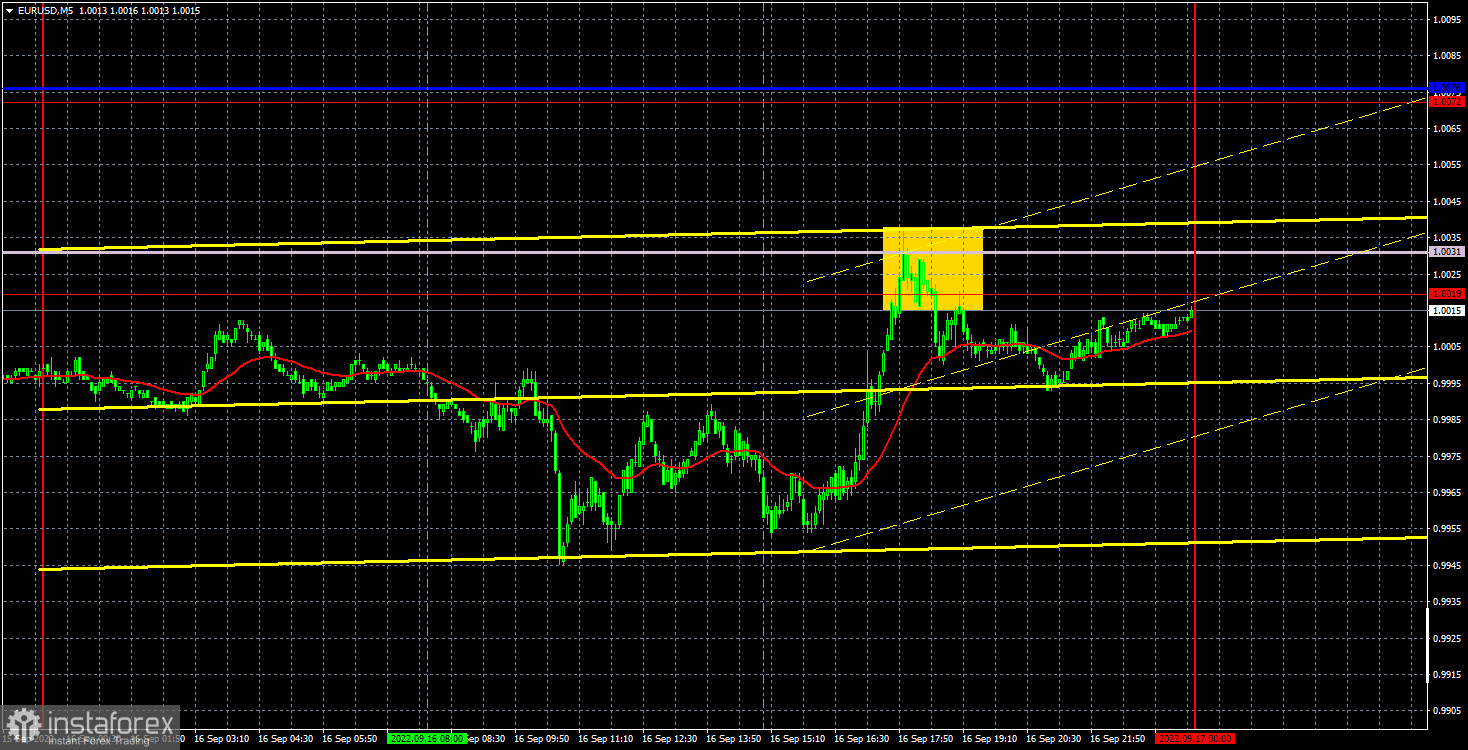EUR/USD 5M analysis.

During the last trading day of the week, the EUR/USD pair again showed no interest in active movements. Basically, after Tuesday, when the US inflation report was published, the movement disappeared, and the flat began. Moreover, this is already another flat near the 20-year lows of the pair. If you switch to a higher timeframe, it is clear that the price has already spent quite a lot of time in a semi-lateral movement. The euro currency can still not adjust normally, so the long-term downward trend remains. On Friday, the European Union published a report on inflation, which is expected to have risen again and is now at 9.1%. Forecasts predicted just such an increase in the indicator. And since the forecasts and the actual value coincided, it is not surprising that there was practically no market reaction. The ECB has just raised the rate for the second time, so it's too early to speculate on what actions the regulator will take at the next meeting due to a new acceleration in price growth.
With trading signals on Friday, the situation was not the best. Only one sell signal was formed as a rebound from the 1.0019-1.0031 area. However, it formed quite late, and the downward movement after that was quite weak. In any case, traders would not have received a loss on a sale transaction, even if they had opened it. But they could not open it. There were no other signals during the day.
COT Report:
The COT reports on the euro currency in the last few months reflect what is happening in the euro/dollar pair. For half of 2022, they showed a frank "bullish" mood of professional players, but at the same time, the European currency was steadily falling. The situation is different, but it no longer favors the euro currency. If earlier the mood was "bullish" and the euro currency was falling, now the mood is "bearish," and the euro currency is also falling. Therefore, so far, we do not see any reason for the growth of the euro because the absolute majority of factors remain against it. During the reporting week, the number of buy-contracts from the non-commercial group increased by 3 thousand, and the number of shorts decreased by 8.3 thousand. Accordingly, the net position increased by about 12 thousand contracts. This is not very much, but it is still weakening the "bearish" mood among the major players. However, this fact does not matter much since the mood remains "bearish," and the euro remains "at the bottom." Professional traders still do not believe in the euro currency. The number of buy contracts is lower than that of sell contracts for non-commercial traders by 36 thousand. Therefore, we can state that the demand for the US dollar is high, and the demand for the euro is quite low. The fact that major players are in no hurry to buy euros may lead to a new depreciation of this currency. Over the past six months or a year, the euro currency has not been able to show even a tangible correction.
EUR/USD 1H analysis.
On the hourly timeframe, the bears' prospects are improving more and more every day, despite the three-day flat. They managed to hold nearly 20-year lows for a long time, not allowing them to adjust. The fact that the ECB has significantly raised the key rate for the second time, as we can see, has not had any positive effect on the euro. Thus, we are waiting for the resumption of the fall in quotes. On Monday, we allocated the following levels for trading – 0.9877, 0.9945, 1.0019, 1.0072, 1.0124, 1.0195, 1.0269, and the Senkou Span B (1.0031) and Kijun-sen (1.0076) lines. The lines of the Ichimoku indicator can move during the day, which should be considered when determining trading signals. There are also auxiliary support and resistance levels, but no signals are formed near them. Signals can be "bounces" and "overcoming" levels-extremes and lines. Do not forget about placing a stop loss order at breakeven if the price goes in the right direction by 15 points. This will protect against possible losses if the signal turns out to be false. On September 19, there will be no interesting events in the States or the European Union. The trend in the last three days can be assumed to continue. However, be careful: on Wednesday, the Fed meeting, and the market may start working out its results in advance. Moreover, they are already practically known.
Explanations of the illustrations:
Price levels of support and resistance (resistance/support) are thick red lines near which the movement may end. They are not sources of trading signals.
The Kijun-sen and Senkou Span B lines are the lines of the Ichimoku indicator, transferred to the hourly timeframe from the 4-hour one. They are strong lines.
Extreme levels are thin red lines from which the price bounced earlier. They are sources of trading signals.
Yellow lines are trend lines, channels, and other technical patterns.
Indicator 1 on the COT charts is the net position size of each category of traders.
Indicator 2 on the COT charts is the net position size for the "Non-commercial" group.





















